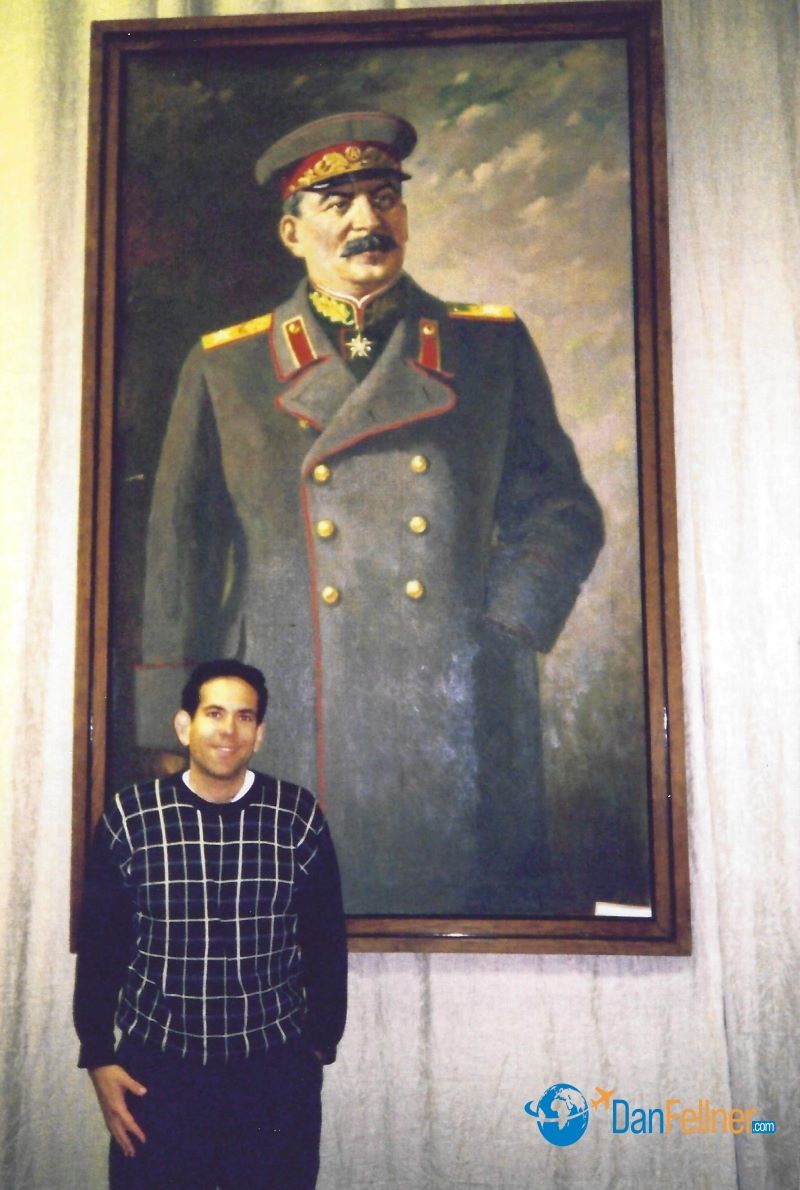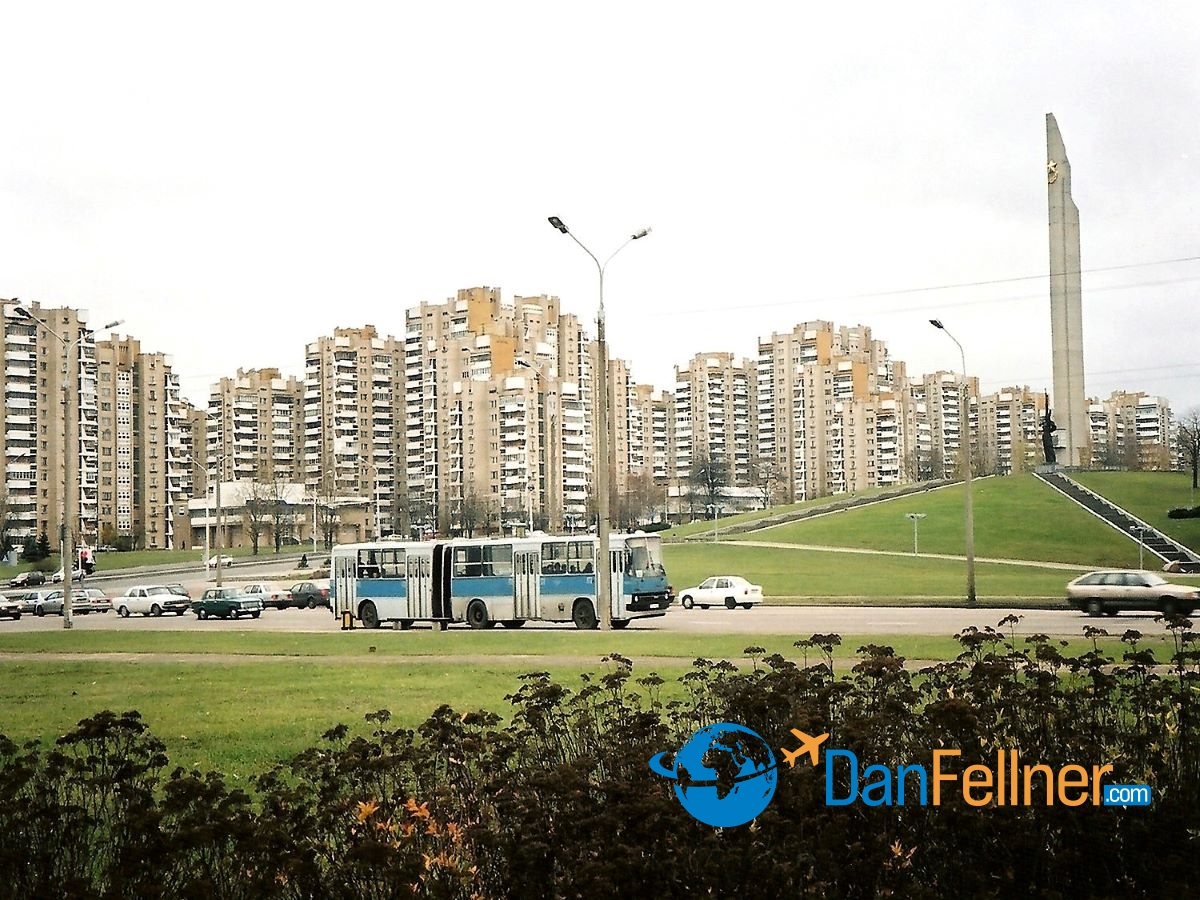Diena (Latvia’s largest newspaper) – Jan. 2, 2003
MINSK, Belarus –As our tour van passes endless tracts of dilapidated, look-alike apartment buildings on the bumpy, pot-holed streets of Minsk, we ask our guide about Alexander Lukashenko, the notorious, iron-rule president of Belarus.

A statue of Lenin in downtown Minsk, Belarus.
“Would you use the word ‘dictator’ to describe him?” we ask. She nods, but then gives us a warning. “I would be careful about using such a word on the streets,” she says. “The police do not like such words.”
Indeed, it isn’t long before we encounter the police, who twice stop our van during the course of the tour to see who we are and what we’re up to. We keep our mouths shut and they let us continue on our way. Our guide says it’s a routine occurrence.
It’s then that I recall the immortal words of Lennon – John, not Vladimir. Visitors to Belarus truly are “back in the U.S.S.R.”
This landlocked country of about 10 million people, which became independent in 1991 when the U.S.S.R. collapsed, remains largely unchanged from Soviet times. The economy is mostly state-controlled and dissenting voices are not tolerated. It’s not uncommon for journalists critical of the government to disappear and our guide told us of friends who were arrested for taking part in anti-Lukashenko demonstrations.

The author posing in front of a portrait of Stalin at a museum in Minsk, Belarus.
Recently, the government banned religious organizations unless they have been present in Belarus for more than 20 years and have at least 20 members. The move was seen as an attempt to boost the dominant Eastern Orthodox Church, while restricting the growth of Protestant groups trying to gain a foothold in the country.
While other former Soviet republics in the region are on the verge of joining NATO and the European Union, Lukashenko’s repressive and outdated policies have made Belarus an outcast in the European community and one of the poorest countries on the continent.
For visitors, it’s a rare chance to step back in time and observe life as it once was behind the Iron Curtain – drab, dreary and downright depressing.
Still, the country has some interesting sites that showcase its rich but tragic history. And you can enjoy them cheaply and in relative solitude. Belarus isn’t exactly a hotbed for tourists.
While relics of communism have been removed from throughout most of Eastern Europe, Belarus proudly puts its on display. A huge statue of Lenin – Vladimir, not John – guards the main government building in the heart of Minsk. Enormous portraits of Stalin can be found in city museums.
The KGB — the Soviet secret police unit — was officially disbanded in 1991. In neighboring Lithuania, the government converted the KGB building into a grim museum that recounts Soviet atrocities. Lithuanians once imprisoned in the building now give guided tours.
But in Belarus, the KGB is still very much in business and is headquartered in a neoclassical yellow building that takes up a full block on Francyska Skaryny, Minsk’s main drag. One can only imagine what would happen if you knock on the door asking for a tour.
A nearby park features a bust of Felix Dzerzhynsky, a native of Belarus who founded the Cheka, the Soviet police unit that preceded the KGB.
The roots of communism can be explored in Minsk at the Museum of the First Congress of the Russian Social Democratic Workers’ Party. The small green wooden building that houses the museum, which was rebuilt after being destroyed during World War II, is where Russia’s original Marxist party held its illegal founding congress in 1898.
Just across the street is a site of interest for Americans with a bit of a morbid streak – a nondescript apartment building where Lee Harvey Oswald, the assassin of President Kennedy, lived when he defected to the Soviet Union from 1959-1962. There are no plaques commemorating the site and few Belarussians know of the building’s dubious significance.

Endless blocks of drab apartment buildings in Minsk, Belarus, a city that has about 2 million residents.
A couple of blocks away, still in operation today, is the television components factory where Oswald worked. From the looks of the outdated TV in our hotel room, it might very well have been assembled by Oswald himself.
Sadly, another relic of communism – slow and indifferent service in hotels, restaurants and stores – has also survived in Belarus. One of those high-paid productivity consultants could do wonders here, as most businesses seem to have far more workers than they need, although few of them ever seem to be doing anything.
At restaurants, the waiters have no incentive to provide good service as a 10 percent “service charge” is usually added to the bill. The communists may have tried to create a worker’s utopia, but the legacy is a diner’s nightmare.
Our hotel, the three-star Hotel Belarus (there are no four- or five-star hotels in the country), was adequate, although we could have done without the paper-thin walls, cloudy tap water and the flock of prostitutes in the lobby. At least some vestiges of capitalism seem to have caught on here.
For a city that’s more than 900-years-old, Minsk doesn’t look its age. It was virtually destroyed during World War II when the Germans and Russians waged a fierce battle for the city. Only a few historic buildings survived.
The horrors of the war, in which about 25 percent of the country’s population perished, are graphically chronicled in one of the finest World War II museums in the world. Officially called the “Museum of the Great Patriotic War,” it features three floors and 28 rooms full of exhibits. There are enough tanks, guns and artillery on display to outfit a small army.

The small village of Valozhyn, 45 miles northwest of Minsk.
Especially horrific are exhibits depicting the Nazis’ extermination of the country’s Jews. One hundred years ago, more than half of Minsk’s residents were Jewish. Today, only a few thousand remain.
Exhibits at the museum are in Russian and Belarussian, the two closely related state languages. But English-speaking guides are available. It’s worth spending several hours here to learn about a period of history that so defines the country today.
The Soviets’ victory gave them a unique opportunity to basically redesign Minsk from scratch. The result is an efficient model of urban planning with wide boulevards and a mass-transit system able to meet the needs of the city’s nearly two million residents. It’s also one of the cleanest and most crime-free capital cities in Europe.
Efficient, yes, but Minsk won’t win any beauty pageants. The only thing that adds some color to the mile-after-mile of towering, gray apartment buildings is the wet laundry hanging from seemingly every balcony.
Escaping the concrete jungle of Minsk to see some of the surrounding countryside makes an interesting daytrip. Villagers still get around in horse-drawn carts and farm small plots of land behind their brightly painted wooden houses. Be prepared to be stared at by the locals, though, as not many visitors venture into rural areas.
Belarus was severely affected by the nuclear disaster in Chernobyl, even more so than Ukraine, where the plant was located. It’s estimated that up to two million Belarussians were exposed to radiation. Even though it happened in 1986, there are still some areas in the far southeastern part of the country that should be avoided.
Once you get there, Belarus is one of the cheapest countries in Europe for tourists. Higher-end hotels cost about $60 a night (locals are charged less), a good dinner can be had for $5 and a ticket for the high-quality opera or ballet will set you back no more than 2,000 Belarussian rubles — about $1.
Amazingly, if you want to visit another part of the country and don’t have the time or patience to take the train or bus, a one-way airplane ticket on the national airline Belavia costs less than $10.
But there’s a bit of expense and hassle before you enter the country. All foreigners need to get a visa in advance, which costs about $50. You also are required to purchase state health insurance and visitors must have a hotel reservation in advance or invitation from a private person.
Belarus isn’t a place for those who want sanitized, pampered vacations with all of the creature comforts of home. But for travelers who never had the chance to visit the Soviet Union, it’s an opportunity to peek into the past at a dying era that one can only hope is gulping its last gasps of breath.
© 2009 Dan Fellner

